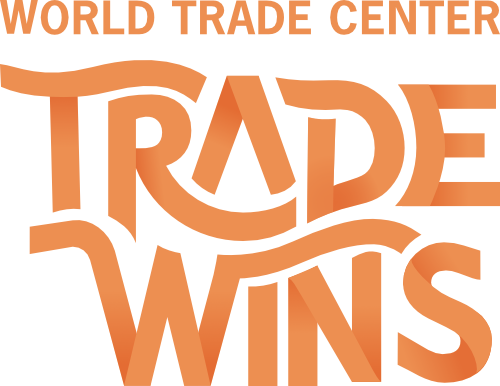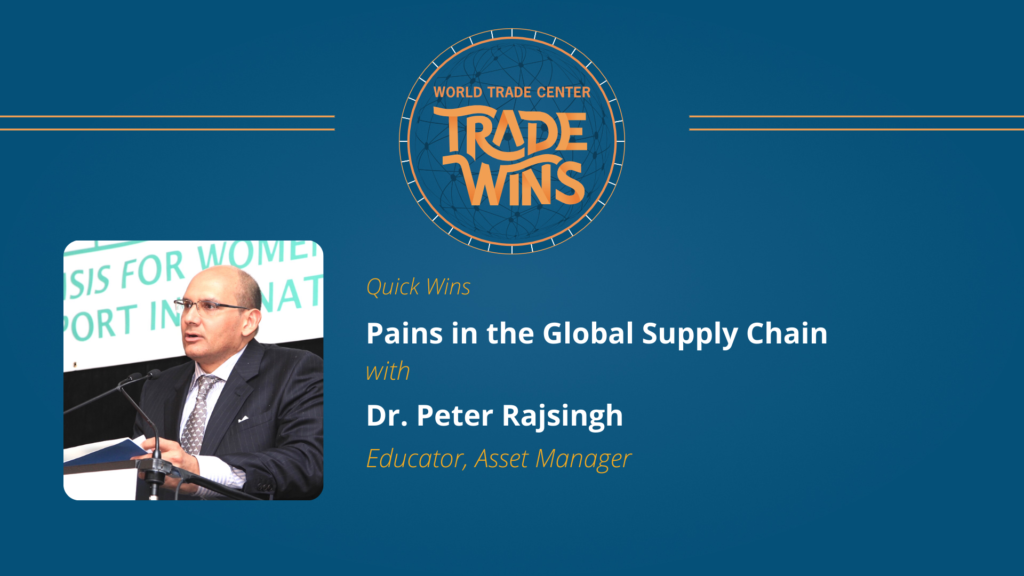Robin van Puyenbroeck 0:08
Welcome back to Trade Wins. This is Robin van Puyenbroeck and I’m welcoming back to the show Dr. Peter Rajsingh. Peter, how are you?
Peter Rajsingh 0:12
Hey, Robin. Very well. How are you? Good to see you.
Robin van Puyenbroeck 0:14
Very well. Yeah, good to see you as well. I thought it was a good time. We’re launching a new, short series “Quick Wins” to sort of discuss some of the more pertinent current issues going on. And what was really on my mind over the past few weeks, and I’m sure I’m definitely not the only one, is the issue of goods not being able to ship and the massive congestion in the supply chain– the supply chain crunch. I wanted to just get your thoughts on that. I saw some interesting data points in The Economist last week where companies didn’t even used to report issues with supply chains and that’s the number one issue. You see companies like Toyota cutting output with almost 20% – 150,000 vehicles. The U.S. Department of Commerce actually pulled companies in the U.S. and the chip inventories have fallen from 40 days to less than five days. What do you make of all this? This entire supply chain issue?
Peter Rajsingh 1:15
Yeah, so two things. Firstly, it’s very interesting, in terms of just how we take things for granted and assume that for instance, when we turn on a faucet, that water will flow and when we expect to buy a fridge or a car that it’s going to be there for us. That’s the first thing, this notion that we’re so used to not grappling with uncertainty or black swan events if you like. So that’s the first thing. And then the second thing has to do with a game that a lot of students play in MBA programs called the BA Game. Basically, it’s about the supply chain. You have different groups of students playing different roles. All of a sudden, a pop group or a rock group mentions a particular beer and a song and the beer gets super hot, and everyone wants it. And so all the different players, all the different actors in the supply chain, start reacting, for instance, over-ordering more, because they can’t keep up with the demand. And then this just creates a series of kind of the opposite of bottlenecks, I mean, in the sense that orders are coming haywire, and everything just gets thrown out of kilter. So the game is that ultimately doing nothing is the best thing. Because when you have anomalous situations, when you start reacting to them, then trying to normalize the scenario becomes very difficult. So what we see in the global supply chain is that when we have the rapid “falling off a cliff” demand with COVID, actors or players in the supply chain start cutting back. And then when demand came roaring back, they weren’t able to cope with all the need for capacity. So as you know, we have issues in commodities, right? Just the lack of the ability to procure the raw materials for production, a good example, obviously semis, which we all know about. Then there’s the labor aspect of supply chains that basically, people were out with COVID and then getting them back to work. And then labor issues. And then finally, as we all know, there’s the container issue and just the logistics, that basically we had ports that were just clogged with containers with empty containers. And then how do you move around a situation that’s completely sclerotic? Where you can’t really get goods into containers, you can’t get empty containers out of the way, you can’t get filled containers, then the whole container shortage issue. So we have kind of a, if you like a kind of perfect storm of a confluence of so many different forces that have just served to stall the whole global supply chain, and also point out the interdependence. And the way different elements just can’t, you know, one, once there’s a breakdown, getting things back in sync is very, very difficult. So my view, and it’s also the view of a lot of other commentators, is that we’re not about to resolve this anytime soon. It is a perfect storm. And then the other corollary issues, obviously, of inflation and so forth, as people fight further the shrunken demand of particular goods that they desperately need.
Robin van Puyenbroeck 4:41
Yeah, it’s a complete misalignment between supply and demand here. There’s a shortage of raw materials. The shipping is completely out of whack. Even if shipping containers get to a port, they can be unloaded, they’re floating for 30, 40 days, then there are no workers on the case because a lot of them are absent because of COVID. It seems like it’s not just about putting one or two pieces back in place, it’s the entire chain from raw material all the way to the consumer because even in the U.S., there was a number out, I have it in front of me, the American Trucker Association said that they currently look for 80,000 lorry drivers that they cannot find. So even if we solve all those problems from the factory all the way to the port, then the products just don’t get to where they need to be because there are no lorry drivers left. So how again, and so because the companies are now and I agree with you, this is going to take a while, although Mars, the shipping company came out and said they hope to resolve most of the issues by the second half of this year. But other large corporations coming out with numbers over the past couple of weeks are not that confident at all. If you then see what the demand is going to do, because with inflation going up, we’re probably going to see at some point also crunch and consumption, that’s going to have another elastic effect on this whole supply chain. Do you see that? What’s your timeline with this?
Peter Rajsingh 6:02
It’s very hard to predict the timeline, but I think whatever the optimistic timeline is, we want to then basically factor for some element of elasticity, that it’s just wishful thinking. And then there’s another dynamic which has now come to the fore, which is that truckers are at the forefront of a kind of geopolitical movement against politicians – protesting against vaccine mandates.
Robin van Puyenbroeck 6:23
In Canada now, of course. The border crossing.
Peter Rajsingh 6:26
It’s now become a global phenomenon. In France, in Wellington, New Zealand, and so that’s further exacerbating the existing problems. So it’s interesting, but basically circling back, it just calls us to begin to be a little more sanguine about things we take for granted.
Robin van Puyenbroeck 6:48
Do you see this also having an impact on reshoring? Which is, of course, in many places of the world, a big political point of discussion as well.
Peter Rajsingh 6:56
Yes. 100%. Reshoring. Another phenomenon is called nearshoring, trying to bring manufacturing to sources closer to our home country. So yes, we have, as a consequence, very good points you make we’re going to see a kind of realignment in terms of how the whole regimes of globalism are going to be viewed and potentially play out in the future.
Robin van Puyenbroeck 7:26
What’s the impact if this would have happened years ago when there was one dominating economic bloc? Now there are at least two or even three that are not necessarily in sync with each other on trade issues? Is there any hope of more sort of coordination collaboration between the major trading blocs to define solutions here? Do you see them being more in sort of an ongoing standoff for the near future?
Peter Rajsingh 7:51
No, I think, probably more of the latter, especially since you have more and more disgruntled populations in countries that push politicians to be less conciliatory and dig their heels in and to be more belligerent, visibly neighbors and less diplomatic. So basically, it’s really another recipe for exacerbating geopolitical tensions as we move away from the very comfortable status quo and notions of stability that we were previously inured to.
Robin van Puyenbroeck 8:24
Thank you for that insight, Peter. Briefly, in closing, what’s your crystal ball? How’s all this going to look like a year from now?
Peter Rajsingh 8:35
Yeah, well, my view on crystal balls follows a great sage Yogi Bear who says, “I never make predictions, especially about the future.” I’m a big “uncertainty” person. I think uncertainty is something that is very underrated and we need to take it seriously and think about how to grapple with it, what opportunities emerge from uncertainties and basically, the future doesn’t resemble the past.
Robin van Puyenbroeck 9:04
I could not agree more. Thank you, Peter. That’s maybe a good topic for a future conversation, how to organize ourselves in a world of uncertainty. Thank you so much. Dr. Peter Rajsingh talking here about supply chain issues. Thank you.
Peter Rajsingh 9:17
Always a pleasure Robin. Great seeing you.
Robin van Puyenbroeck 9:21
If you have any ideas for future episodes, know someone who would be an inspiring guest, or just want to stay apprised of our show, please make sure to connect with our team via email at podcast@wtca.org. Be sure to head over to podcast.wtca.org and subscribe to the show. We will see you soon.






